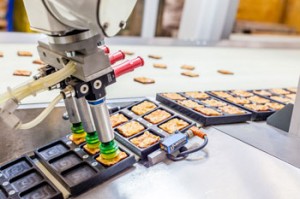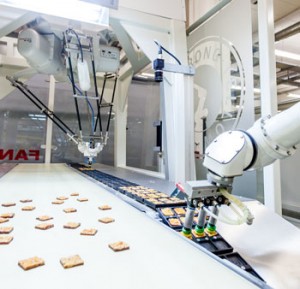Food grade robot technology sees increased demand
 To demonstrate the benefits of robotics within the food industry, FANUC has developed a food grade robot picker cell, combining both an articulated arm food grade robot and a delta style food grade robot. The IP67 certified food picker cell (measuring 4×2.2m and 2.35m tall) is designed to orientate and pack a wide variety of unpackaged and packaged foods, including confectionery, baked, snack and dairy items.
To demonstrate the benefits of robotics within the food industry, FANUC has developed a food grade robot picker cell, combining both an articulated arm food grade robot and a delta style food grade robot. The IP67 certified food picker cell (measuring 4×2.2m and 2.35m tall) is designed to orientate and pack a wide variety of unpackaged and packaged foods, including confectionery, baked, snack and dairy items.
At one end of the food grade robot picker cell is a ceiling mounted four axis M3iA/6s delta style loading food grade robot. Capable of 120 picks per minute, this food grade robot has a 6kg payload and a work envelope of 0.5m deep by 1.350m diameter. The delta style system orientates products taken from a conveyor and places them into a plastic blister tray ready for secondary packing. With its white epoxy finish and food grade grease, the food grade robot arm can withstand tough cleaning regimes which use acid and alkaline products.
At the other end of the cell, an M430iA/2P articulated arm food grade robot demonstrates a typical unloading scenario removing products from the trays back onto the conveyor. Mountable in a variety of positions including floor, wall or invert, the six axis M430 food grade robot maximises flexibility for tight workspaces and can also complete 120 cycles per minute – matching the delta.
FANUC reports that it has seen significantly increased demand from the food industry for its food grade robot technology over the last twelve months, with companies looking to automated their food handling and packing operations. FANUC says food grade robot enquiries have increased by 35%.
“We’ve strengthened the business case for food grade robot adoption by providing the necessary functionality that a food producer needs.”
“Food manufacturers face a number of challenges in their production operations,” comments John Rainer, Regional Sales Manager of FANUC UK. “In a manual process, they must deal with ergonomic issues, labour availability and the uncertainty of increasing costs associated with legislation. In an automated process, accommodating rapid-fire product and pack changes driven by sustainability initiatives and shelf impact, as well understanding and improving key performance measures such as Overall Equipment Effectiveness (OEE), are key. And in any process, food safety is an overriding concern on the minds of processors, as the consequences of foodborne illness and/or massive product recalls have affected a wide range of food categories.”
FANUC’s latest robots have been designed specifically to work in the harshest of environments, and in addition to being smaller, stronger and faster, they incorporate the latest vision technology to improve the robot’s ‘sight’. “We’ve strengthened the business case for food grade robot adoption by providing the necessary functionality that a food producer needs,” said John.
 Although the cost of a food grade robot has reduced (for example the cost of FANUC’s latest palletiser is 7% lower compared to its predecessor, yet has a 12% increase in payload capacity), this alone hasn’t improved their viability in the food industry comments John: “Many barriers to entry have been address, for example only in the last 12-18 months have we made available IP69K certified robots to meet the toughest of hygiene standards.”
Although the cost of a food grade robot has reduced (for example the cost of FANUC’s latest palletiser is 7% lower compared to its predecessor, yet has a 12% increase in payload capacity), this alone hasn’t improved their viability in the food industry comments John: “Many barriers to entry have been address, for example only in the last 12-18 months have we made available IP69K certified robots to meet the toughest of hygiene standards.”
Over the course of the last 10 years, food manufacturers have faced greater pressure to adhere to increasingly stringent levels of compliance, whether responding to individual Retailer Codes of Practice (COP) or the latest requirements set out by the British Retail Consortium. “Manufacturers looking to improve hygiene, by removing the uncertainty that the human element brings to the equation, have been driving the need for food grade robots.”
He continues: “The incredible pace at which vision technology is developing, now with a more economical price tag, greatly improves the accuracy of sorting, picking and placing countless food objects randomly placed across numerous line.” Visual line tracking used by the M3iA/6S food grade robot to locate the parts, incorporates integrated queue management, so that up to four food grade robots can be directed by a single FANUC iRVision camera. The picker cell also uses FANUC’s new iRPickTool software which simplifies setup for line tracking systems and minimises programming for customers with picking applications. The software divides incoming product so that each food grade robot in the system picks an equal number of products. It can also assign a specific percentage of products for each food grade robot to pick.
Now with energy reducing technology built into all FANUC products to reduce power usage with savings in the region of 20%+, and guaranteed 25 year parts availability (including obsolescence avoidance solutions), there’s never been a better time for food producers to invest in food grade robot technology.
Visit the FANUC website for more food grade robot information.
See all stories for FANUC















